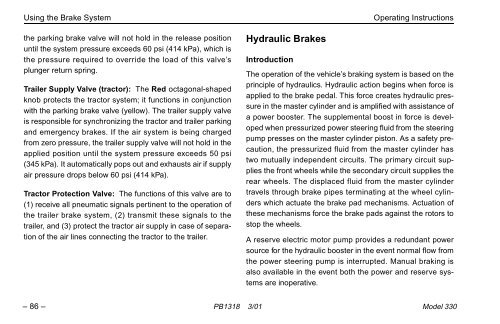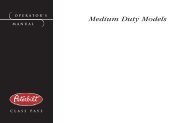MODEL 330 OPERATOR'S MANUAL - Peterbilt Motors Company
MODEL 330 OPERATOR'S MANUAL - Peterbilt Motors Company
MODEL 330 OPERATOR'S MANUAL - Peterbilt Motors Company
Create successful ePaper yourself
Turn your PDF publications into a flip-book with our unique Google optimized e-Paper software.
Using the Brake System<br />
the parking brake valve will not hold in the release position<br />
until the system pressure exceeds 60 psi (414 kPa), which is<br />
the pressure required to override the load of this valve’s<br />
plunger return spring.<br />
Trailer Supply Valve (tractor): The Red octagonal-shaped<br />
knob protects the tractor system; it functions in conjunction<br />
with the parking brake valve (yellow). The trailer supply valve<br />
is responsible for synchronizing the tractor and trailer parking<br />
and emergency brakes. If the air system is being charged<br />
from zero pressure, the trailer supply valve will not hold in the<br />
applied position until the system pressure exceeds 50 psi<br />
(345 kPa). It automatically pops out and exhausts air if supply<br />
air pressure drops below 60 psi (414 kPa).<br />
Tractor Protection Valve: The functions of this valve are to<br />
(1) receive all pneumatic signals pertinent to the operation of<br />
the trailer brake system, (2) transmit these signals to the<br />
trailer, and (3) protect the tractor air supply in case of separation<br />
of the air lines connecting the tractor to the trailer.<br />
Hydraulic Brakes<br />
Introduction<br />
Operating Instructions<br />
The operation of the vehicle’s braking system is based on the<br />
principle of hydraulics. Hydraulic action begins when force is<br />
applied to the brake pedal. This force creates hydraulic pressure<br />
in the master cylinder and is amplified with assistance of<br />
a power booster. The supplemental boost in force is developed<br />
when pressurized power steering fluid from the steering<br />
pump presses on the master cylinder piston. As a safety precaution,<br />
the pressurized fluid from the master cylinder has<br />
two mutually independent circuits. The primary circuit supplies<br />
the front wheels while the secondary circuit supplies the<br />
rear wheels. The displaced fluid from the master cylinder<br />
travels through brake pipes terminating at the wheel cylinders<br />
which actuate the brake pad mechanisms. Actuation of<br />
these mechanisms force the brake pads against the rotors to<br />
stop the wheels.<br />
A reserve electric motor pump provides a redundant power<br />
source for the hydraulic booster in the event normal flow from<br />
the power steering pump is interrupted. Manual braking is<br />
also available in the event both the power and reserve systems<br />
are inoperative.<br />
– 86 – PB1318 3/01 Model <strong>330</strong>
















